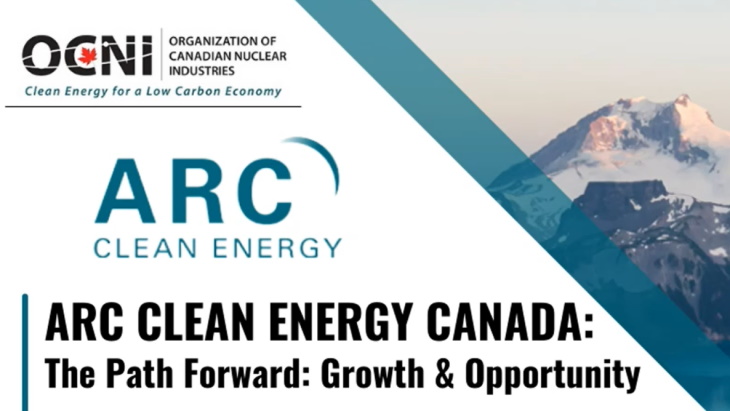NUKE NEWZ
New Brunswick fast reactor operational 'within the decade'
07 October 2021
A 2029 start-up for an ARC-100 advanced small modular reactor in New Brunswick is an "aggressive" but achievable target, the CEO of ARC Clean Energy Canada said yesterday. Bill Labbe was speaking at an event hosted by the Organization of Canadian Nuclear Industries (OCNI), held as the company prepares to begin the second phase of the Canadian Nuclear Safety Commission's Vendor Design Review (VDR) process.

ARC, along with NB Power and Moltex Energy, is part of an SMR vendor 'cluster' established in New Brunswick in 2020 with the aim of establishing an SMR supply chain in the province and deploying SMRs at NB Power's existing Point Lepreau site, which is currently home to a 660 MWe (net) Candu 6 reactor. The Government of New Brunswick earlier this year announced CAD20 million (USD16 million) in funding towards the advancement of the ARC-100 sodium-cooled fast reactor. The Government of Canada has also this year announced funding to advance the design of Moltex's Stable Salt Reactor - Wasteburner and WAste to Stable Salt (WATSS) facility, and has also announced funding for NB Power to prepare the Point Lepreau site for SMR deployment and demonstration, and to the University of New Brunswick to expand its capacity to support SMR technology development.
Also speaking at the OCNI event were Andy Hayward, director of advanced reactor development at NB Power, and Bill Cooper, vice-president of engineering at ARC, as well as New Brunswick Minister of Natural Resources and Energy Development Mike Holland. The event was chaired by OCNI President and CEO Ron Oberth.
The ARC-100 is a 100 MWe fast reactor that leverages proven technology developed at the Experimental Breeder Reactor-II (EBR II) sodium-cooled fast-reactor, which was developed at the US government's Argonne National Laboratory where it operated successfully for thirty years. The inherent safety characteristics and passive safety features of this design have already been proven, Hayward said. Currently, activities are focusing on preliminary design work, the VDR process, and development and preparation work at Point Lepreau, as well as progressing supply chain activities and First Nations and public engagement.
The timeline for ARC-100 commercialisation has been "accelerating", Labbe said. The first - Scoping - phase was completed in 2019; the second phase - Preliminary Design, which includes the second VDR phase, the completion of preliminary design work, validation of cost estimates and integrated schedule, as well as scoping fuel supply and manufacturing capabilities - is now under way and is expected to be completed by the end of 2023. Phase 3, which will include completion of the detailed engineering, procurement orders, construction permit licensing and approval, site preparation work and the execution of a construction contract, is scheduled to run until 2026.
The final - deployment - phase will run from 2027-2030, according to the timeline, and the company expects the first core to be delivered on site by the end of 2028, Labbe said. "I haven't seen anything in our schedule yet that moves us beyond [a 2029 operational date]", he added. "It's really coming down to a resource constraint at this point. Those are the types of things that we can manage."
"The other part is the regulatory approval. We need to have good quality documents, good discussions, good interface with regulatory agencies, and we need to make sure we provide them with everything that they need so that they can make decisions in a timely manner. That's a piece that's a little bit out of our control, but we can certainly set that stage very well with what we deliver, and that will enable our schedule to progress."
"We are in an envious position in New Brunswick, with the support of the New Brunswick government, a utility that has a long history of operating nuclear power plants, and a technology that's very mature and well proven," Cooper said. "This is an exciting time for SMRs and we don't have any obstacles in front of us that we can't get through to have one of these units up and running within the decade."
Researched and written by World Nuclear News
By: Jesslyn Shields | Oct 6, 2021

Thorium pellets used inside the Bhabha Atomic Research Centre (BARC)
nuclear research reactor in Mumbai, India.
As climate change makes the planet less pleasant to live on, nuclear power is getting more attention. Solar and wind energy can help cut greenhouse gas emissions, but if a solution can be found to climate change, nuclear power is probably going to be part of it.
But although nuclear power is carbon-free, it's risky. For starters, disposing of radioactive waste from nuclear power plants presents an insoluble problem — what to do with such dangerous byproducts? Also, what happens if the core melts down and creates a deadly environmental catastrophe, as happened in Fukushima, Japan, in 2011? There are other concerns as well, but there are a lot of reasons to keep plugging away at making nuclear power safer.
Nuclear reactors are run by fission, a nuclear chain reaction in which atoms split to produce energy (or in the case of nuclear bombs, a massive explosion).
"Approximately 450 nuclear reactors are in operation worldwide, and they all need fuel," says Steve Krahn, a professor in the department of civil & environmental engineering at Vanderbilt University, in an email. "For the most part, these reactors operate on Uranium-235 (U-235), and the nations that partially recycle the fuel — France, Russia and a few other countries — mix in a little recycled Plutonium-239 to make what's called mixed-oxide fuel."
Plutonium is a byproduct of used fuel from a nuclear reactor; it's highly toxic and its radioactivity doesn't drop very quickly — it takes tens of thousands of years for it to achieve safe levels of radiation, whereas thorium breaks down to a safe level in around 500 years.

German physical chemist Otto Hahn was awarded the Nobel Prize for chemistry in 1944 for his discovery, with Fritz Strassmann and Lise Meitner, of the nuclear fission of uranium and thorium.
STF/AFP/GETTY IMAGES
What Is Thorium?
Some scientists think the element thorium is the answer to our nuclear problems. Thorium is a slightly radioactive, relatively abundant metal — about as abundant as tin and more abundant than uranium. It's also widespread, with particular concentrations in India, Turkey, Brazil, the United States and Egypt.
Thorium isn't a fuel like uranium. The difference is that uranium is fissile, meaning that it produces a runaway chain reaction if you can get enough uranium in one spot at one time. Thorium, on the other hand, is nonfissile or "fertile," meaning you have to bombard the thorium with neutrons — essentially jump-start it with a small amount of radioactive material like uranium — so it can transmute into a uranium isotope (U-233/Th-232) for creating power.
Thorium Pros and Cons
Thorium was used in a lot of early nuclear physics experiments — Marie Curie and Ernest Rutherford worked with it. Uranium became more heavily associated with the nuclear process during World War II, because uranium is better for making bombs, but for power generation, thorium has some real benefits over uranium. Thorium is more efficient than uranium, and its reactors may be less likely to melt down because they operate at lower pressures. In addition, less plutonium is produced during reactor operation, and some scientists argue thorium reactors could destroy the tons of dangerous plutonium waste that have been created and stockpiled since the 1950s. Not only that, thorium is thought to be nearly proliferation-proof, since plutonium can't be separated out of the waste products and used to make bombs.
There are a few downsides to thorium, however. One is that, although thorium and its waste products are dangerous for hundreds rather than tens of thousands of years compared with uranium or plutonium, thorium is actually more dangerously radioactive in the short term. For that reason, thorium can be a bit harder to work with, and it's trickier to contain it. It is also more difficult to prepare than uranium rods: According to Krahn, if we are going to power our planet using a thorium fuel cycle, sufficient U-233 must be produced to fuel the initial reactors.
"Methods to chemically process Th-232 and U-233 are fairly well established; however, facilities to accomplish such chemical processing would need to be constructed," says Krahn.
Using Thorium for Energy
There are several ways thorium could be applied to energy production. One way is to use solid thorium fuel in a conventional water-cooled reactor, similar to modern uranium-based power plants. Another prospect that has been exciting to scientists and nuclear power advocates is the molten salt reactor. In these plants, fuel is dissolved in a vat of liquid salt. The salts have a high boiling point, so even huge temperature spikes will not lead to explosions. In addition, molten salt reactors don't require a lot of cooling so they don't need a huge amount of water to operate. For that reason, a thorium-powered nuclear reactor is being tested in the Gobi Desert in China.
Now That's Interesting
Thorium was discovered by Jons Jakob Berzelius in 1828, who named it after Thor, the Norse god of thunder.
No comments:
Post a Comment